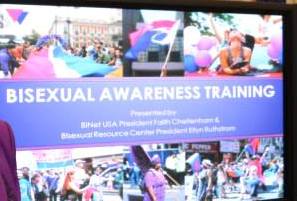
Washington DC — 9.23.13
If you knew bisexuals experience rape, partner violence, and stalking more than any other segment of our sexual orientations, would you keep silent? If you were offered a national platform to give voice to their stories, could these sad statistics be revealed without perpetuating the many hateful stereotypes about bisexuals?
I asked myself these questions as I prepared to join a contingent of 33 bisexual activists from around the country who were invited to speak with key members of the Obama Administration on September 23, 2013, known for almost 15 years as “Celebrate Bisexuality Day.” This was a significant opportunity on an auspicious day!
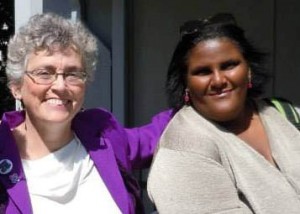
Ellyn Ruthstrom, President, Bisexual Resource Center, and Faith Cheltenham, President, BiNet USA, mobilized 33 bi activists to meet with Obama Administration officials.
For the first time ever, bi leaders were going to be very visible and their voices would be heard by public officials who make policies that affect us all.
With about one month to prepare, we divided into small, issue-focused groups and got to work preparing talking points on policy issues. My group’s mission was to cover domestic and intimate partner violence experienced by bisexuals. Others spoke on bullying and hate crimes, health, HIV/AIDS, employment and more. It was challenging to break the silence on domestic violence, while protecting the survivors’ anonymity and respecting their dignity.
Like the old gospel song says, we need to make “a way out of no way” to help all people feel valued and respected; to be safely visible while being bisexual.
After immersing ourselves in piles of research reports and assessing the state of domestic violence advocacy in this country, we realized that we needed to bring those hidden, invisible bisexual survivor voices directly into that Old Executive Office Building conference room. So we read brief excerpts from their stories.
When one battered woman from Chicago went looking for a safe place to live, she had not one, but two doors slammed in her face instead—because she was bisexual:
“The shelter staff told me I didn’t belong there, that they only served women abused by male partners. They referred me to a new gay community anti-battering project. That group also turned me away, saying that I was bisexual, not gay, so they couldn’t help me…What I felt too angry and defeated to say back then was, ‘why can’t services be designed with bisexuals in mind?’ If we design services sensitive to bisexuals, they end up being responsive to both heterosexual and gay people, don’t they?”
A young woman from Texas told us that when she was 13 her sexual abuser labeled her a bisexual as a way to control and molest her before she understood what it meant. “I instantly felt shamed.”
We emphasized the disturbing and appalling statistics from the CDC’s 2010 National Intimate Partner and Sexual Violence Survey on victimization by sexual orientation: 61% for bisexual women as compared to 44% for lesbians and 35% for heterosexual women. The violence stats for men were 37% for bisexuals compared to 26% for gay men and 29% for heterosexual men.
As an adult, an intimate partner used her bi orientation to manipulate and control her. “…negative stereotypes about bisexuality helped spark his abuse of me, the trauma, complete isolation, and total dependence upon him at that time.”
Our last anecdote came from an older Maryland woman who married young and had several children. “My husband knew about my bi orientation before we married. It was not an issue,” she told us. “…soon after our marriage, he began to psychologically abuse me… I resolved to finish college so that I could have the self-sufficiency to leave him. In my senior year, he launched a custody battle; using my bi orientation to imply I was an unfit mother…I survived this trip through hell, but still have the scars. It feels much safer to pass as heterosexual. Even today, a bisexual orientation can still be used as a weapon.”
Why do many bisexuals opt to remain invisible? We distributed a Massachusetts social service group’s brochure that reads, “Does Your Partner Blame It on Your Bisexuality?” We covered the findings of a Seattle group’s[i] research: “shelters are simply not accessible; lesbian and bisexual women experience pernicious problems in their stays, and for almost every confidential shelter… gender-variant people and bisexual and gay men are explicitly ineligible for services.”
We emphasized the disturbing and appalling statistics from the CDC’s 2010 National Intimate Partner and Sexual Violence Survey on victimization by sexual orientation: 61% for bisexual women as compared to 44% for lesbians and 35% for heterosexual women. The violence stats for men were 37% for bisexuals compared to 26% for gay men and 29% for heterosexual men.
At the White House roundtable, I wanted to implore our government and our society to do the impossible: create/defend/empower humane solutions to domestic violence…to not stigmatize or ignore bisexual victims…to not blame depression, suicide, addiction, and workplace problems on people just for BEING bisexual.
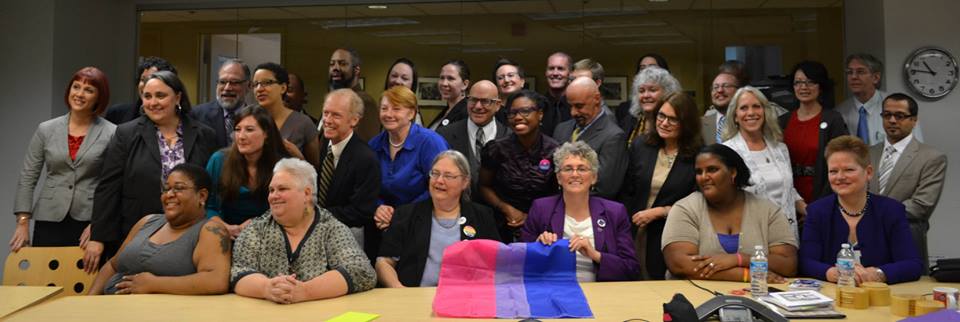
Bisexuals were well-represented at the White House roundtable by our group of intrepid bi advocates.
Last month’s meeting was both a challenge and an honor to speak with high-level government officials on behalf of bisexual women and men. As a long-time Washingtonian and bisexual advocate, I totally understand the irony of lobbying for better treatment from the federal government, yet not holding our collective breath; of learning to celebrate bisexual pride in the midst of sorrow; of crafting anthems of resistance and insistence despite our fears.
Like the old gospel song says, we need to make “a way out of no way” to help all people feel valued and respected; to be safely visible while being bisexual.
Special thanks to the members of our bi roundtable team on Domestic and Intimate Partner Violence: Heron Greenesmith, Gary North, Chiquita Violette, Morgan Goode and Lindasusan Ulrich.
[i] From Connie Burke’s 2008 speech to an ABA group on LGBT domestic violence issues.
 After my mother, Adele Hutchins, died in mid-December I made a photograph of her china the wallpaper on my cell phone. The fluted silver platter and two ivory tea cups with gold rims and roses appealed to my sense of beauty. So now they haunt me.
After my mother, Adele Hutchins, died in mid-December I made a photograph of her china the wallpaper on my cell phone. The fluted silver platter and two ivory tea cups with gold rims and roses appealed to my sense of beauty. So now they haunt me.
Why? They are the level of comfortable living I was told was my birthright, the prize of being a suburban housewife to which Betty Freidan said we all aspired, the measure which, since I never comfortably achieved it, probably now never will, given my age, approaching Medicare’s gate this May. This silver plate, these delicate tea cups, represent the concepts “dining room” and “china cabinet,” neither of which have been in my personal property vocabulary for many years.
It is fashionable this week to remember Freidan’s Feminine Mystique, marking the 50 year anniversary since its release. Freidan spoke to those women of my mother’s post-WWII 50’s generation, women who married and got the china cabinets, the silver plates and gold-rimmed tea cups, from their middle-class inheritance and husbands’ good blue collar and white collar jobs.
Though she lived until she was 88 and lived the last decade of her life alone, I don’t think my mother ever understood what it was for me to grow up single, independent, un-partnered for most of my life. It was a way of life she’d never encountered first hand until she was a widow, and by then the rest of her life-span was planned out and protected, provided for by privileges her marriage, her class status and society at the time provided for women of her race and class.
So no one taught me how to save money, how to manage investments (like grandmother’s house, when I had it, a great big house with dining room and even some left-over china, after the cousins had grazed through). I held onto that house for 12 years but eventually traded it back to the bank to pay down some of my grad school debt and move in with Andrew, what a mess that was. Still recovering from it, in some ways. But at the time it seemed a sensible next step. Ever since the beginning of this new century I have been off-loading property; managing, negotiating, juggling furniture, roofs, walls and infrastructure repairs and making homes for people to live in, communally. I’m really tired of it, too. Nan and I both here, holed up here in the cold winter together with our elderly cats, in Takoma Park, in a rental property I’m currently in custody of, a place with no room for mother’s china cabinet, which got shipped off to a cousin’s girlchild during the recent emptying of mom’s apartment after her death.
It’s ridiculous I have this big flashy purple-and-black, zebra-striped comforter I haven’t spread out on the bed since I bought it in October. It’s February now and I shiver in bed sometimes, but it’s so beautiful I don’t want to get cat hair on it. Am I waiting for my elderly cat to die? Well, he’s loyal, in his own twisted way, and I’ve lived with him longer than anyone else so I return his loyalty in my own grudging way.
My mother and grandmother and aunt (forget the men for now) brought me up to expect to live in a house with a dining room and china cabinet, a home with linen closets and cedar chests, fire places and bathrooms with genuine guest towels, all of that. Instead I live camped out in someone else’s home, in a basement storage area wrapped around a furnace room. Not as bad as it sounds, it’s actually a big one-and-a-half room suite w/office, bedroom and bath. Certainly no room for big furniture or tiny china tea cups to be properly displayed though.
I know we Tauruses are supposedly really rooted in and into the material world. And I love treasuring things as much as the next person; especially bright colors and contrasting textures and shapes, smells, sounds. I just can’t deal with how easily they accumulate and take over, I feel a commensurate need to keep them at bay in my life, lest they weigh me down. Perhaps my life is more guerilla, more gypsy than I was bred for.
This troubles me. And yet it just is, a stark function of my expectations that we face more societal upheavals in the near future, must be prepared for changes at a moment’s notice. Personal treasures and possessions seem to be perhaps some of the least important things we will keep track of or care about. Community, fellowship and companionship with others is what we all thrive with, long for, and, if we’re lucky, can create as we go along. And while I’m embarrassed that I often spend weekends depressed and withdrawn, humoring myself back into humanness so I can function enough to hold onto this sanctuary space I retreat in, yet I’m also grateful, simply, to have the freedom to weather this angst, to still have this place of peace amongst increasing uncertainties. In the meantime, any vessel is my tea cup, every plate my silver platter.
We live at a time in postmodernity in which the themes of past eras have found their way back into our collective consciousness. Viral epidemics and pandemics such as HIV, swine flu, and bird flu have replaced bacterial plagues. Inverted totalitarianism has replaced imperialism. Multi/transnational corporations have replaced empires. Wars on Islamic extremism have replaced the Crusades. The impact of these forces upon our collective consciousness is to force dichotomous, binary thinking. We are pressured to believe in right and wrong, good people and bad people. We are encouraged to be suspicious of nuance, complexity, ambiguity, and the diunital, i.e., the union of opposites. Spirituality and religion, like sexuality, can be sites of contestation or compliance. They can broaden and expand our ability to embrace the liminal or embolden hostility toward liminality .
These may seem like lofty ideas, so theoretical as to be meaningless to the average person. Ask the bisexual-identified Muslim who wishes to enter the United States with a dildo about how theoretical these issues are. Ask the pansexual hotel worker who is using a prayer to the Orishas to remain healthy because s/he has no health care or job security if these issues are too removed from what is happening in everyday people’s lives. Ask the machinist with two lovers, recently laid off and now dependent upon the food bank of the church, who is being told by a right wing media pundit that the Chinese or Mexicans are to blame for unemployment if these issues don’t have tangible material consequences. Ask the bi academic, shuttling between assignments to several different classes at several different colleges trying to scrape together a living wage and still maintain her/his connection to grace as a part of the large pool of contingent faculty in higher education, if these issues are too academic. We live in a time when we are being pressured to contract inward upon ourselves and see queerness—sexual, spiritual, political, or social—as too radically inconvenient for the moment.
Even movements that intend to exact more freedoms have contributed to the denial of same. The way in which the gay liberation movement has engaged heterosexism has contributed to popular culture narratives of categorical sexualities with straight and gay as fixed, infallible, and totalizing forms of sexual identity. Same-sex marriage advocacy has been practiced in ways that are antagonistic to marriage equality. Authentic marriage equality would have to include polyamorous relationships between more than two partners and genderqueer relationships that embrace gender expressions beyond the binary of male and female.
We, therefore, have to take care to be critically self-reflective as we move in the world, particularly if we intend our actions to have socially just and ecologically sound consequences. How we frame our loves, sexual and sacred, can play an important part in critical self-reflexivity. We see this special issue of the Journal of Bisexuality on bisexualities and spiritualities as a contribution to that framing. In this introduction, we offer you our summary of what’s inside, the highlights and gaps, what we found interesting and what we still long to read about, areas where we feel the intersecting fields of bisexualities and spiritualities still have glaring present absences and absent presences. We chose to look at spirituality in the context of bisexuality or through a bi/pan/polysexual framework because of the opportunity the framework offers to disrupt the dichotomous and offer the liminal and diunital in considering spirituality. We also wanted to see if there were spaces within theology and spirituality that had not been excavated, or could not be excavated, by a heterosexist or homosexual-centric framework.
This special issue began as the spiritchild of Loraine Hutchins. Loraine, one of the founders of the modern bisexual movement in the U.S., is known for instigating conversations about how bisexual-, pansexual-, and polysexual-identified persons experience, conceptualize, and practice spirituality and religiosity from the uniqueness of their lived erotic experiences. This interest stems from her previous work on the sacred and the sexual (Hutchins, 2007, 2002, 2001). In seeking a collection of work that was inclusive of various traditions and cultural contexts, she sought out writers who could contribute to the desired diversity of voices. H. Sharif Williams (Herukhuti), a sex radical shaman of the Hip Hop generation, saw the original call for papers for the special issue and sought out Loraine. Through conversation, we discovered our common threads. Ibrahim Abdurrahman Farajajé served on both of our doctoral dissertation committees. We were colleagues of M. Paz Galupo—for Loraine as coworkers at Towson University and for Herukhuti as a contributor to a special issue of the journal guest edited by Paz (Williams, 2007). We also discovered how much we were each called to explore the sacred and the sexual.
We decided to partner on the special issue as guest co-editors. Our collaboration demonstrated a bridging across cities, generations, genders, ethnicities, and spiritual traditions. We hoped to be the nuance, complexity, ambiguity, and diunital that we want to see in the world. As we performed the editorial tasks associated with a journal issue such as drafting and distributing the call for papers, soliciting manuscript submissions, identifying peer reviewers, etc., we shared our work and her/histories with each other. We chose to make the relationship nuanced, complex, and deep. We learned about each other’s loves, sexual and sacred. We rejected the option to have a disembodied and desacralized academic process. The space we created allowed us to engage in critical self-reflection and critical feedback with each other.
We share these various aspects of our process with you to provide context for this special spirit issue, and to contribute to the project of dismantling the depersonalized, disembodied academic. To open the discussion of where we have come from and where we are going in these pages, we offer this prayer/invocation to our readers:
May you find joy
May you create love
May you experience grace
May you know peace
May you give birth
May you inspire lust
May you apply wisdom
May you offer honor
May you share ecstasy.
Excerpted from Our Hearts Still Hold These Intimate Connections:
An Introduction to the Spiritualities Special Issue of the Journal of Bisexuality, which later became Sexuality, Religion and the Sacred: Bisexual, Pansexual and Polysexual Perspective, Routledge, 2012, co-editors, Loraine Hutchins & H. Sharif Williams, Goddard College
I knew Miss Smith intimately the last thirteen years of her life. […] Life was serious, real, to her. She walked with her feet on terra firma, not in the clouds. She was a woman of high sentiment, but not sentimental. She never uttered diatribes against married life, but she always commended it; yet she was content to remain unmarried, fully persuaded that was the life God meant for her.
John M. Greene, “An Address at the Centennial of the Birth of Sophia Smith,” 27 May 1896, p. 17f.
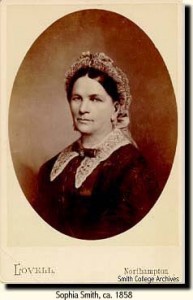
Sophia Smith
I began keeping a diary in 1963, the same year my mom took me downtown to hear Martin Luther King’s magnificent speech. A natural historian, I love to document events and cherish others who do so. Part of my original motivation that summer was wanting to chronicle what was happening around me. I was also motivated by the sheer idiocy of the local news media which had described the upcoming March on Washington for Jobs and Freedom as a lawless dangerous occurrence, liable to “cause unrest and riot among the Negros and imperil the windows of downtown storefronts.” No violence occurred at that march, the newspaper pundits were proven wrong. In fact it ended up being a hugely positive turning point, ushering in the Voting Rights Act and much more social progress, until King’s brutal murder in 1968.Now someone will save my journals, and collected papers, for posterity, and I’m thrilled. I just signed an agreement with Smith College to house my papers – collected articles, correspondence, and other filed documents, which represent my 40+ years of activism in a wide span of social justice (housing, peace, Latin American solidarity, environmental, LGBT, women’s, civil rights) movements. Some of my articles from the 70s are already deposited at the Lesbian Herstory Archives, founded by one of my long-time heroines and literary inspirations, Joan Nestle. But I’m not a lesbian nor is my life’s work only focused on lesbians so while I’m proud my papers from the early 1980s about the Seneca Women’s Peace Camp are there, it didn’t make sense to ask them to take any more of my collection. Then I thought about donating the papers to one of several bisexual history archives (east or west coast) but there are more than bisexual papers in my collection. I also thought of donating them somewhere in my hometown, Washington, DC. But the Rainbow History Archives does’t currently have the capacity Smith does, and it felt great to be among so much women’s history, nestled in those mountains of Western Massachusetts among all those women’s schools.
It wasn’t easy getting to this place. In fact it took over three years of agony, dealing with a storage unit several miles from my house filled with file cabinets, bookcases and boxes that I poured through month after month, with the assistance of several valiant college interns. We weeded and winnowed, saying goodbye to precious photographs and one-of-a-kind rare ‘zines, etc. Finally, at the end of this past August, I successfully shipped 29 boxes up to Smith and the next stage of my life, sans boxes and storage unit began. Hurrah, hurrah ! The folks at White Oak Storage Plus, Zack and Gloria and their assistant Sarita, were grand. They held my hand through the whole process, even helped me avoid scheduling the boxes shipping date so it didn’t coincide with one of their famous auctions (see Storage Wars, a reality tv special on this strange American phenomena of what happens when hoarding meets death, bankruptcy and the consequent blind bidding on other peoples’ “stuff”).
Thanks to Nan Mandelkorn, Dave Hawkins and Jose (my moving crew, last day), 
as well as Katie Meixner (intern extraordinaire) and Claudia Ramos (earlier intern who helped with the first stages several years ago), to Heather Harts’horn who inspired this whole project to begin with, and to Joan Biren, my long-time neighbor, colleague, and friend, whose earlier relationship with Smith’s collection originally inspired me to send my papers there.
Sometime soon I hope to have a fun citation on Smith’s special collections website like Joan Biren’s link , after the wonderful Sophia Smith Archives staff unpack my boxes and figure out how to describe what’s in them for future researchers to harvest. The collection will house my writings and research files, and eventually hold my 50+ years of journals, after I’m gone. I confess I do fantasize about young researchers finding treasurable nuggets in a way distant future, after I’ve long ago joined the ranks of the ancestors and my legacy is complete.
For those of you wanting to see more of this marvelous collection, check out these links: http://www.smith.edu/libraries/libs/ssc/video.html
http://www.smith.edu/libraries/libs/ssc/about.html
News of the the recent media splash made by musical artist Frank Ocean’s disclosure about his attraction to more than one gender came to me by way of my friend and co-editor, Herukhuti. In an article for BiMagazine.org, Herukhuti wrote,
“In 2012, some folks find it more provocative that a black man has loved another man than if he had done violence against one.”
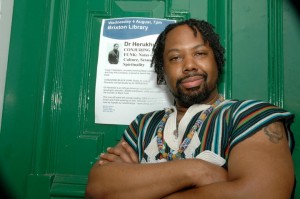
Dr. H. Sharif Williams or Herukhuti.
Herukhuti also noted that in a recent journal entry, “…Ocean eloquently explores his experience of love toward/with/for an undisclosed man…Media sources have alleged that the self-disclosure was precipitated by a music reviewer noting instances in Ocean’s forthcoming debut studio album in which the singer/songwriter uses male pronouns in expressing love and Eros toward someone.”
It takes a lot of courage for a man to be so honest, but it’s especially impressive that Ocean chose to go public about his fluidity when his debut album, Channel Orange, was just released.
Newer Entries »« Older Entries









